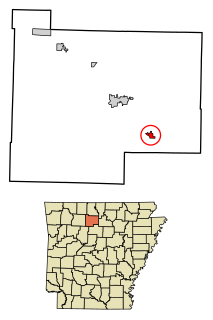
The Dermott Commercial Historic District encompasses the historic commercial heart of the rural community of Dermott, Arkansas, in the Mississippi River delta region of southeastern Arkansas. The Dermott area was settled in the 1840s, and the town was by the 1880s a thriving railroad town. The commercial district was developed principally in the first three decades of the 20th century. The district consists of three city blocks: two on East Iowa Street and one on North Freeman Street. The oldest building is the Bordeaux building at 209 East Iowa.

The Arkadelphia Commercial Historic District encompasses the historic commercial core of Arkadelphia, Arkansas, the county seat of Clark County. Arkadelphia was settled in 1842, and its commercial district is located in one of the older parts of the city, near the Ouachita River. Most of the buildings were built between c. 1890 and c. 1920, and are built out of brick and masonry; the oldest building in the district is estimated to have been built in 1870.
The Stuttgart Commercial Historic District encompasses a portion of the commercial center of Stuttgart, Arkansas. The district extends along Main Street between 1st and 6th Streets, and includes a few buildings on the adjacent numbered streets as well as Maple and College Streets, which parallel Main to the west and east, respectively. The majority of the district's 76 buildings were built between about 1900 and 1920, and are brick commercial structures one or two stories in height. Notable among these buildings are the Riceland Hotel, the Standard Ice Company Building, and the county courthouse.
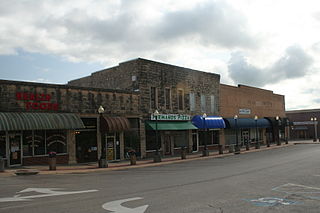
The Mountain Home Commercial Historic District encompasses the historic central business district of Mountain Home, Arkansas, the county seat of Baxter County. The district is centered on the Baxter County Courthouse, and is bounded on the north by East 5th Street, the south by East 9th Street, the east by South Street, and the west by South Hickory Street. Most of the buildings in this area are commercial structures, one or two stories in height, of masonry construction. They are generally vernacular in style, and most were built in one of two periods: between about 1900 and 1920, after the arrival of the railroad, and in the 1950s, when the city experienced another major period of growth. The oldest building is the 1892 Baker Building at 601-603 Baker Street.
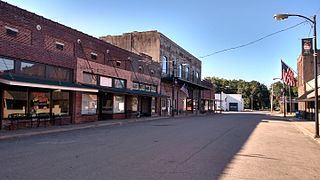
The Augusta Commercial Historic District encompasses the historic commercial center of the city of Augusta, Arkansas. Located on the eastern bank of the White River, Augusta developed in the late 19th and early 20th centuries as a major crossing point of the river in eastern Arkansas. Located between the river and Second Street, and between Pearl and Mulberry Streets are a collection of 44 historic buildings, including warehouses along the waterfront and commercial and retail buildings on the adjacent streets.

The Faucette Building is a historic commercial building at 4th and Main Streets in North Little Rock, Arkansas. It is a two-story masonry structure, with three storefronts, and a false parapet above the second floor. It was built in 1890 by William Faucette, one of the leading citizens of the unincorporated area of Argenta. The area was annexed to Little Rock in the 1890s, and it was Faucette who engineered the formation of North Little Rock in the early 20th century.

The Farmers Bank Building is a historic commercial building at Main and Walnut Streets in Leslie, Arkansas. It is a single-story brick structure, with its entrance angled at the street corner. The main facade is three bays wide, all with round arches trimmed in limestone. Built about 1910, this Romanesque Revival building house the Farmers Bank until it failed in the 1930s, and then the local post office for a time.

The Meek Building, also known as the Hogg Building, is a historic commercial building at Main and Oak Streets in Leslie, Arkansas. It is a two-story brick building, with a flat roof obscured by a parapet. Its main entrance is in an angled section at the street corner, with a second store entrance facing Oak Street. Built about 1907, it is one of the oldest commercial buildings in the city, and has long been a local landmark, first housing the grocery of Roy Meek and then the meat shop of G. W. Hogg.

The Missouri and North Arkansas Depot-Leslie is a historic railroad station at the end of Walnut Street in Leslie, Arkansas. It is a long rectangular single-story building, with stone walls and a bellcast hip roof with extended eaves. A telegrapher's bay projects from the southwest side. It was built c. 1925, and is a surviving representative of the economic success brought to the community with the arrival of the railroad in 1903.

The Peter Joplin Commercial Block is a historic commercial building at 426-443 Ouachita Street in Hot Springs, Arkansas. It is a two-story masonry structure, with retail storefronts on the ground floor and offices above. It is architecturally undistinguished, with nods toward the Tudor Revival in its styling. Built in 1905, after a fire had swept through the area, it is one of the only buildings in the area to survive an even larger fire in 1913. As such, it is a rare surviving example of early 20th century commercial architecture.
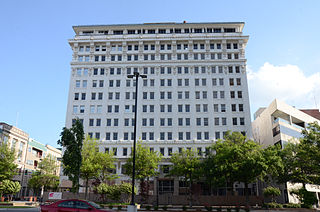
The Capitol–Main Historic District encompasses a well-preserved area of early 19th-century commercial architecture in downtown Little Rock, Arkansas. The district includes 2-1/2 blocks of Capitol Street, extending east from Center Street, one block of Main Street south of Capitol, and one block of 6th Street west of Main. The buildings in this area were mostly built before World War II, and are of a more modest scale than modern sections of the downtown. Notable buildings include the LaFayette Hotel and the Pfeifer Brothers Department Store.

The Hotel Pines is a historic commercial building at the northwest corner of West 5th and Main Streets in Pine Bluff, Arkansas. It is a large six-story U-shaped masonry structure, with a two-story section filling the center of the U. The center section has a portico projecting over the sidewalk, with Classical Revival detailing and paired columns for support. Built in 1913 and in operation as a hotel until 1970, it was Pine Bluff's grandest hotel.
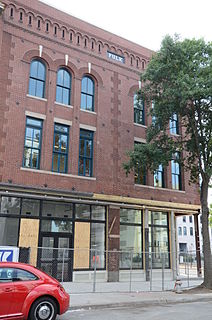
The Fulk Building is a historic commercial building at 300 Main Street in Little Rock, Arkansas. It is a three-story brick Romanesque Revival building, with commercial storefronts on the ground floor, and two-story round-arch bays on the upper levels. Built about 1900 for attorney and landowner Francis Fulk, it typifies buildings that lined Main Street around the turn of the 20th century, and is one of its better examples of Romanesque architecture.

The Pine Bluff Commercial Historic District encompasses a portion of the historic city center of Pine Bluff, Arkansas. It extends from Barraque Street south along Main Street, extending in places to properties alongside streets. The area's commercial development began about 1840, when the courthouse square was laid out at Barraque and Main, and proceeded through the early 20th century. Most of the commercial properties of the district were built between 1880 and 1910, and are reflective architecturally of late 19th-century commercial building styles.

The Heber Springs Commercial Historic District encompasses the early commercial heart of Heber Springs, Arkansas. The district extends along Main Street, between Broadway and 6th Street, including several buildings along some of the cross streets. The area was developed beginning in 1881, and grew in the late 19th and early 20th centuries, featuring a diversity of commercial architecture from that period. Prominent buildings include the Cleburne County Courthouse (1914) and the Morton Building at 101 South 3rd Street, the city's oldest surviving commercial building (1895).

The South Main Street Residential Historic District encompasses a residential area south of downtown Little Rock, Arkansas. The area, extending along South Main Street roughly between 19th and 23rd Streets, was developed between about 1880 and 1945, and includes a well-preserved set of residential architecture from that period. Notable buildings include the Luxor Apartments, the Holcomb Court Apartments, and the Ada Thompson Memorial Home.

The West 7th Street Historic District encompasses a collection of early 20th-century commercial buildings on the 800-1100 blocks of West 7th Street in Little Rock, Arkansas. The thirteen buildings of the district were built between 1906 and 1951, and are mainly one and two-story masonry buildings with vernacular or modest commercial Italianate style. The Clok Building at 1001 W. 7th, built in 1915, notably has an elaborate concrete facade.

The Dardanelle Commercial Historic District encompasses the part of the historic central business district of Dardanelle, Arkansas. The district extends along Front Street, from Pine Street in the north to nearly Oak Street in the south, and includes some properties on adjacent cross streets. Although this area has been commercially active since the 1820s, its present architecture reflects the late 19th and early 20th centuries, with modestly scaled one and two story masonry building predominating.

The Paris Commercial Historic District encompasses much of the commercial heart of downtown Paris, Arkansas. Centered on the courthouse square, where the Logan County Courthouse, Eastern District is located, the district contains a well-preserved collection of mainly commercial architecture from the turn of the 20th century. The district includes the buildings facing the courthouse square, as well as additional buildings extending down South Express and South Elm Streets, and the cross streets between them.

The Leslie Commercial Historic District encompasses a one-block historic area of downtown Leslie, Arkansas. The basically linear district runs on Main Street between Oak and Walnut Streets, and includes 18 buildings and a small city park. Most of the buildings were built in the early decades of the 20th century, and are one and two-story brick buildings.

